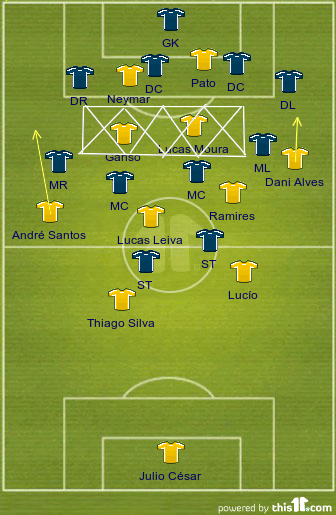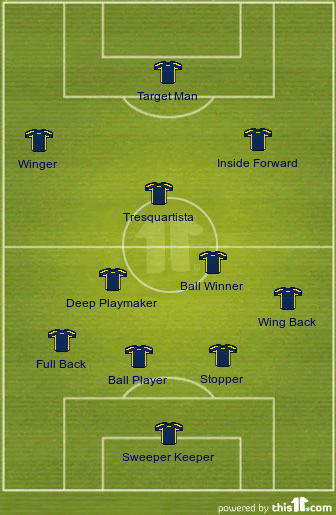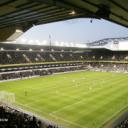![]() mojojojo101When Mano Menezes took over from Dunga after last summers dissapointing World Cup he promised to bring more attacking flair back to the Brazil team in preperation for 2014. However afther the recently finished Copa America it seems that his plans have not really come together for Brazil's last competitive set of fixtures before the next World Cup. This got me thinking, what changes would need to came about for Menezes to deliver on his promises?
mojojojo101When Mano Menezes took over from Dunga after last summers dissapointing World Cup he promised to bring more attacking flair back to the Brazil team in preperation for 2014. However afther the recently finished Copa America it seems that his plans have not really come together for Brazil's last competitive set of fixtures before the next World Cup. This got me thinking, what changes would need to came about for Menezes to deliver on his promises?
My Conclusion was quite simple, a return to a formation inspired by the old Brazil teams' 4-2-2-2. The times when Ganso looked really threatning at the Copa America is when Jadson, another playmaker, was deployed on the right hand side instead of Robinho, unfortunately this only lasted for 45 minutes. This is how I got to the formation above:
When attacking the formation would morph into something like against a 4-4-2: 
The opposition midfielders either have to drop back a long way giving Lucas Leiva and Ramires time on the ball or push up on to them giving acres of space to Ganso and Lucas Moura in the hole (the yellow area). Neymar and Pato are also capabale of dropping into that zone to give them even more headaches.
If the Strikers are used to mark Lucas Leiva and Ramires then there is a very real risk of them being dragged very deep and offering no goal threat themselves (due to powerful runs into gaps by Ramires created by the front four).
Obviously an important part of getting this to work would be time on the pitch so that the front 4 can get to know each other's playstyles better and, Pato especially, learns to make the right run at the right time.
What do you guys think, would a more 'classical Brazilian' approach be the way forward or would continuing with the more European feel of the current team work better?
25.07.2011
 mbillington10One difficulty with the 4-2-2-2 formation is that it encourages the opposition to defend very narrow (unless Brazil play someone with an aerial threat, such as Fred). By defending narrow the opposition can limit the space available between the lines, meaning that the ball is often worked to the full back who then has very few passing options ahead of him. At Villareal, this formation works with great success, but part of the reason for this is that the two forwards, Nilmar and Rossi, are comfortable running towards the wings or dropping very deep, which draggs the centre backs and full backs apart and creates space for the two midfield runners (Valero and Santi). It is highly effective, but they have been playing this way this year for a number of years, and as you pointed out it is very difficult to implement attacking patterns when the players haven't played regularly together.
mbillington10One difficulty with the 4-2-2-2 formation is that it encourages the opposition to defend very narrow (unless Brazil play someone with an aerial threat, such as Fred). By defending narrow the opposition can limit the space available between the lines, meaning that the ball is often worked to the full back who then has very few passing options ahead of him. At Villareal, this formation works with great success, but part of the reason for this is that the two forwards, Nilmar and Rossi, are comfortable running towards the wings or dropping very deep, which draggs the centre backs and full backs apart and creates space for the two midfield runners (Valero and Santi). It is highly effective, but they have been playing this way this year for a number of years, and as you pointed out it is very difficult to implement attacking patterns when the players haven't played regularly together.
At international level, I think 4-2-3-1 is the most effective formation, like how Brazil played against Paraguay (in the quarter final), because this is the formation most players are used to playing at club level, and it offers a good balance between defence and attack, provided the right players are selected. Even though Brazil were knocked out against Paraguay, they had more shots, possession and goalscoring chances than Paraguay. One potential drawback is that the 4-2-3-1 formation asks a lot of Ganso, as he is required to link the defence and attack as Ozil does, something which he may struggle to do on a consistent basis against highly organised opposition, due to his inexperience.
But there are so many variables such as the Dani Alves or Maicon conundrum... who to play on the right of midfield... and the undeniable effectiveness of Fred as the target man against Paraguay. It is very difficult to say what will be successful. I'm still in shock that Marcelo, Hernanes and Hulk have not been included in the squad for the friendly with Germany.
For international games, I think you should pick a formation that best suits the players you have available, rather than trying to cram them into the manager's favourite formation. This works the best when the manager chooses players who suit the role within that formation, rather than picking a player who has a bigger reputation and trying to ask him to do a job he is not suited to. This is what Oscar Tabarez did with Uruguay, he initially tried Cavani on the right of midfield, but then realised he wasn't as effective as Gonzalez was in that position, so made the necessary change. Even though it meant leaving out one of Europe's best strikers, Uruguay's play improved considerably.
Here is my opinion of the best formation
25.07.2011
 NorfLondenBrazil didn't have the squad to match the expectations. No tactical wizardry could have helped that.
NorfLondenBrazil didn't have the squad to match the expectations. No tactical wizardry could have helped that.
26.07.2011